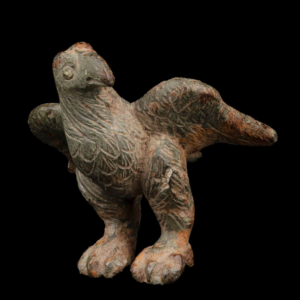By Dorothea Shefer-Vanson

MEVASSERET ZION, Israel — Under the title “Early Birds: Soaring with the Ancients,” the Bible Lands Museum in Jerusalem has put together an exhibition of archaeological items from the Land of Israel and the Ancient Near East depicting birds of various kinds. Upon entering the exhibition area and before inspecting even one of the many items on display, the visitor’s ears are assailed by the sound of bird calls, cries, and song, ranging from waterfowl to the tiny colibri birds that love the brightly colored hibiscus flowers that abound in Israel today.
Everyone knows about the pivotal role played by the dove in the Biblical story of Noah’s ark, so it is especially intriguing to come across a tiny sculpture of a dove accompanied by a plaque explaining the mythological significance of the dove in the ancient cultures of the region. Thus, the dove was the symbol of love associated with the Mesopotamian fertility goddesses Inanna and Ishtar, and also served as a metaphor for lovers in Akkadian poetry, featuring in a similarly symbolic way in the Song of Songs. The symbol of the dove with an olive twig in its beak has in fact become a universal symbol of peace.

Both in ancient and modern kingdoms the eagle has come to represent supremacy, empire, and dominance over others, and representations of this majestic and powerful bird are to be found in the tombs of the pharaohs as well as in the seals and crests of European monarchies and royal dynasties.
Another display case contains a statuette depicting the falcon god Horus, who was one of several gods in ancient Egypt shown in this way. One statuette shows Horus as a falcon, and the other as a man with a falcon head. In both the god wears the double crown, symbolizing the union of Upper and Lower Egypt.
A charming mosaic depicting a peacock was found in Syria and dates to the Roman period. The peacocks symbolized resurrection for the Romans and also featured in Christian art and Byzantine synagogue mosaics from the Land of Israel. Another entrancing mosaic, this one from the Land of Israel or Jordan, dates from the 6th or 7th century CE and shows a chukar partridge strutting out boldly.
A well-lit display case contains four enormous ostrich eggs, found in the Land of Israel and dating from between 3500 and 3550 BCE. Due to their size and thick waterproof shell they were used as luxury vessels in ancient Near Eastern cultures. The oldest egg on display is around 5,500 years old.
It is encouraging to note that all the inscriptions and labels accompanying the exhibits are in Hebrew, English, and Arabic, as befits a museum which was founded by archeologist and collector Dr. Eli Borowski in the belief that “the future of mankind has its roots in the past…only through understanding our history can we build a better future.”
*
Dorothea Shefer-Vanson is an author and freelance writer based in the Jerusalem suburb of Mevasseret Zion, Israel. She may be contacted via dorothea.shefer@sdjewishworld.com